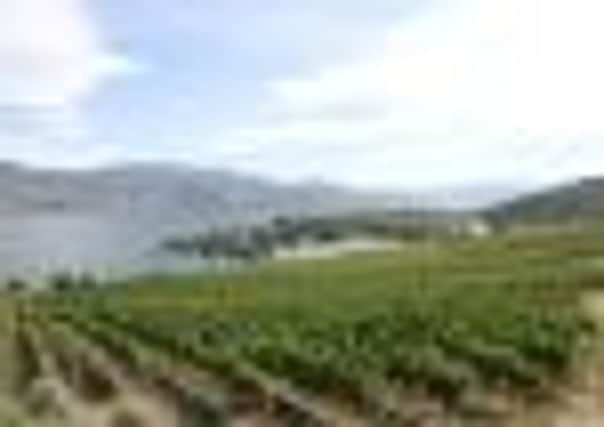Well off the beaten track


But with every cloud and all that, my summer break in Vancouver brought the wines of the Okanagan within striking distance of my taste buds, and having sampled many of them in the fabulous, fish-focussed restaurants of downtown Vancouver, I decided to head off to check out the vineyards.
While there are vineyards on Vancouver Island and surrounding Vancouver in the Fraser Valley, the main concentration of vineyards is 250 miles away in the Okanagan Valley.
Advertisement
Hide AdAdvertisement
Hide AdThe first thing I learnt about Canada is that everywhere is a long way away. What looks like an hour’s drive on a map takes the best part of a day, but the roads are good, the scenery is fabulous and there is always the chance that you might see a bear. Sadly or maybe thankfully, the only bears I saw on this trip were the pair in a reserve on Grouse Mountain, but there were plenty of deer along the route and I managed to avoid the baby moose which decided to cross the road in front of my car.
The Okanagan Valley lies east of Vancouver, over a range of hills and mountains which shelter the region from the Pacific rain clouds. Streams run off these mountains, starting first as a mere trickle along the roadside, widening to a major river by the time I reached the valley. At the heart of the valley is the massive Okanagan Lake, around 100 miles long and three miles wide, running north to south. Rivers and a string of other lakes mean that this almost desert-like area is a lush, green oasis. As well as creating a water sports tourist venue, the lake moderates the climate and so avoids the worst of Canadian winters.
This is a fruit-based agricultural area and grapes have been grown here for over a century, but it was a change in trade agreements with the States that kick-started the modern phase. In order to compete effectively, old-style vines were uprooted in the 1980s and classic vinifera grapes were planted. Now the region has around 4,000 hectares of vineyards, about four times bigger than the whole of the UK vineyards, mainly concentrated around the Okanagan Lake.
The growing season is relatively short. Spring is late but the summers are hot, sometimes reaching 40C, then a long, slow autumn allows the grapes to ripen gently, retaining key acidity.
Advertisement
Hide AdAdvertisement
Hide AdMy first visit was to the Nk’Mip (In-ka-meep) winery owned by the Osoyoos Indian Band which sounds like they might strike up a tune, but these are the aboriginal owners of a vast reservation in the south of the Okanagan, butting right up against the USA border. They are an active, working group of people and many are employed in the cultural centre, hotel, winery and restaurant on site. Despite many touristic references to the classic images of North American Indians, such as the statue of a warrior in a feathered headdress which greets visitors at the entrance, it is clear that this is the modern face of first nations’ living. In the winery I met assistant winemaker Aaron Cray, a member of the Osoyoos Indian Band and he is just like many young winemakers, gathering international winemaking experience in New Zealand and other winemaking countries and bringing it back to his home winery. The wines here reflect the local almost desert-like growing conditions, with deep concentrated flavours, particularly in the reds. I enjoyed the Qwam Qwmt Syrah 2008 for its peppery, savoury fruit ($34.99)and the Qwam Qwmt Riesling Ice wine 2011 ($60) which is made from grapes frozen on the vines at -12C for at least four days, then slowly fermented to make a concentrated, sweet wine full of peachy, baked apple fruit with vibrant acidity.
Close by, the Burrowing Owl winery stands on a hill overlooking a swathe of vineyards. Owned and run by the Wyse family this 70 hectare estate is the fourth largest in British Columbia, but even so, it is small. It was a chance find of an old map-book which triggered Jim Wyse’s interest in buying land. He stumbled across the government report which plotted the best areas for grape growing but this had largely been forgotten in the period of change from hybrid to vinifera vines. With this information Jim has gathered together some of the best vineyard land mainly on the west-facing Black Sage Bench, a deep stretch of sand, which is low in organic matter but which produces powerful reds, particularly Syrah and Cabernets. Burrowing Owl Syrah 2009 ($33) is packed with dark fruit flavours and spicy tones while the Bordeaux blend Meritage 2009 ($45), has clear cassis flavours with notes of sage and coffee. Heading about 50 miles north alongside the lake to Kelowna I greatly enjoyed visiting Quail’s Gate Winery which certainly has the best view I have ever seen from a tasting room. Located on the side of an extinct volcano, the vineyards slope down to the lake and making this a fabulous location. The wines too are pretty good. Here the summer temperatures are more moderate, so whites and Pinot Noir do particularly well. I really enjoyed the refreshing style of the Chasselas, Pinot Blanc blend as well as the lime-zesty Riesling 2011 while the 2010 Pinot Noir showed real complexity, elegance and balance.
Atop the hill, winery Mission Hill stands like a beacon, combining tourism with winemaking and doing a good job of both.